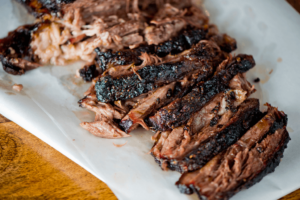There are two types of kolache. Those that are made here Central Texas and those that are not. Depending on where you grew up and your nationality you will have a different vision and definition of a kolache.
I am very familiar with kolache. They are tiny sweet cookie like morsels filled with sweetened fruit and cream cheese. Cherry, raspberry, prune, poppy seed, cheese and apple fillings peak through the wrapped delicate dough. But, the signature “one” is filled with apricot. If you are eating one you know it is the real deal. They are also shaped like tiny-bow ties dusted with powdered sugar. Sometimes they are round in shape. These, I am told, are Bohemian kolache.
In Central Texas the kolache’s appearance and fillings are very different. First of all, they are square and fairly large in size. They are also puffs of sweet delicate dough that are pale yellow in color. Like the Bohemian kolache, the Texas version is also filled with a generous amount of fruit filling in the center.
Its origin
Historically, kolache became popular in Central Europe in the 1700s. They were primarily served at wedding receptions and celebrations. According to Wikipedia, the name originates from the Czech, and from the Old Slavonic word “kolo” meaning circle or wheel. However, the kolache wasn’t an essential part of Texas culture until the 1850s through the 1900s when thousands of Czech immigrants entered the port of Galveston. And, these days, the kolache is a Texan staple.
The defining differences
Yeast vs. cream cheese dough. The first difference between the two is the dough. The Texas kolache’s pillowy, yellow appearance can be attributed to the yeast and egg yolks used to form the dough. Its counterpart has neither. The primary ingredients are butter and cream cheese.
Savory vs. sweet. But, wait. What about kolache with sausage in the middle? The proper name for the sausage variety is klobasnek. If you migrated here from other parts of the country, you probably are not too familiar with klobasnek. And, that is because they are also Czech and original to the state of Texas. Therefore, the second difference between the two recipes is that the Texas version can also be savory and include meat and cheeses. Bakeries and factories in Central Texas offer a variety of savory options. These sandwich-like versions are perfect for breakfast, lunch, dinner, or a mid-afternoon snack. And, their fillings are only limited by the creativity of those baking them.
The process. Growing up both my grandmother and mother rolled the dough out on a flat surface then cut them in two-inch squares. Next, came the fillings, then the two opposite corners were folded to the center to form the shape. Making Texas kolache is a little more hands-on. Since you are using yeast, you have to knead the dough then let it rise. However, instead of rolling the dough out on a flat surface you roll a small piece of the dough in your hand one at a time. Lastly, you form the dough into a circle. Baking time is quick.
Where to buy kolache
If you are in Chicago or Minneapolis you are most likely going to be able to buy Bohemian kolache in bakeries that specialize in European pastries. You may also find klobasnek. In Central Texas, though, kolache reign in the city of West. Located off of I-35 it is 20 miles north of Waco and 120 miles north of Austin. The city of West has a vibrant Czech culture. Today, it is known as the Czech Heritage Capital of Texas. It is also home of the official kolache of the Texas Legislature and Westfest, an annual event celebrating Czech heritage.
Want to try to make your own? Here’s two recipes from the web to get you started: Bohemian and Klobasnek. Whichever type you prefer there is no denying that they are both equally delicious. With mounds of fruit fillings, meat, cheeses, and creative combinations, satisfaction is guaranteed!


